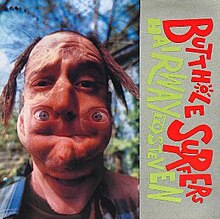Hairway to Steven
| Hairway to Steven | ||||
|---|---|---|---|---|
 |
||||
| Studio album by Butthole Surfers | ||||
| Released | April 11, 1988 (US) 1988 (UK) (Australia) |
|||
| Recorded | January 1988 Dallas, Texas |
|||
| Genre | Avant-garde, hardcore punk, noise rock, experimental rock, neo-psychedelia | |||
| Length | 41:22 | |||
| Label |
Touch and Go (original release) Latino Buggerveil (1999 reissue) Blast First Au Go Go |
|||
| Producer | Butthole Surfers | |||
| Butthole Surfers chronology | ||||
|
||||
| Professional ratings | |
|---|---|
| Review scores | |
| Source | Rating |
| Allmusic | |
| Rolling Stone | |
Hairway to Steven is the fourth full-length studio album by American experimental rock band Butthole Surfers, released in April 1988. All songs were written by Butthole Surfers, co-produced by Butthole Surfers and Ric Wallace, and mixed by Wallace. The album was recorded at January Sound Studio in Dallas.
The album was originally released on Touch and Go, and was reissued on Latino Buggerveil in 1999.
Hairway to Steven's title is a play on Led Zeppelin's popular song, "Stairway to Heaven." Some of its tracks also make allusions to other famous musicians, such as Julio Iglesias.
The last full-length Butthole Surfers album of the 1980s marked a midway point in the band's career, straddling their psychedelic noise roots and the more accessible recordings that would follow. Like Butthole Surfers' previous releases, Hairway to Steven uses non-traditional instrumentation, extensive tape editing, and sound modulation. Unlike its predecessors, which relied almost exclusively on a foundation of electric guitar, bass, and dual drummers, it makes equally heavy use of the acoustic guitar.
This was drummer Teresa Nervosa's final studio recording with Butthole Surfers.
Live performances of all the album's songs, with the exception of "Julio Iglesias," were included on 1989's Double Live. "John E. Smoke" continues to be a regular feature of their concerts.
This album used no actual song titles when originally released; each song was represented by an absurdist, often scatological cartoon printed on the vinyl record's label and in the CD's packaging. In the years since, fans have extrapolated the songs' actual names by cross-referencing this album with official and bootleg recordings of the Surfers' live performances, particularly 1989's Double Live. Many online music services use these widely accepted titles (see "Track listing").
...
Wikipedia
